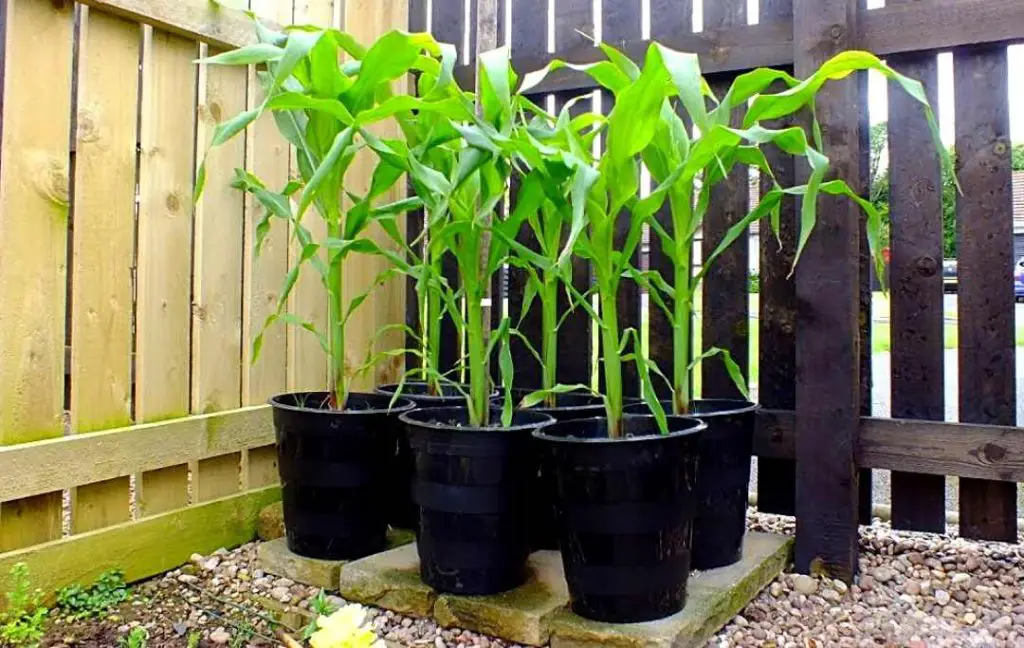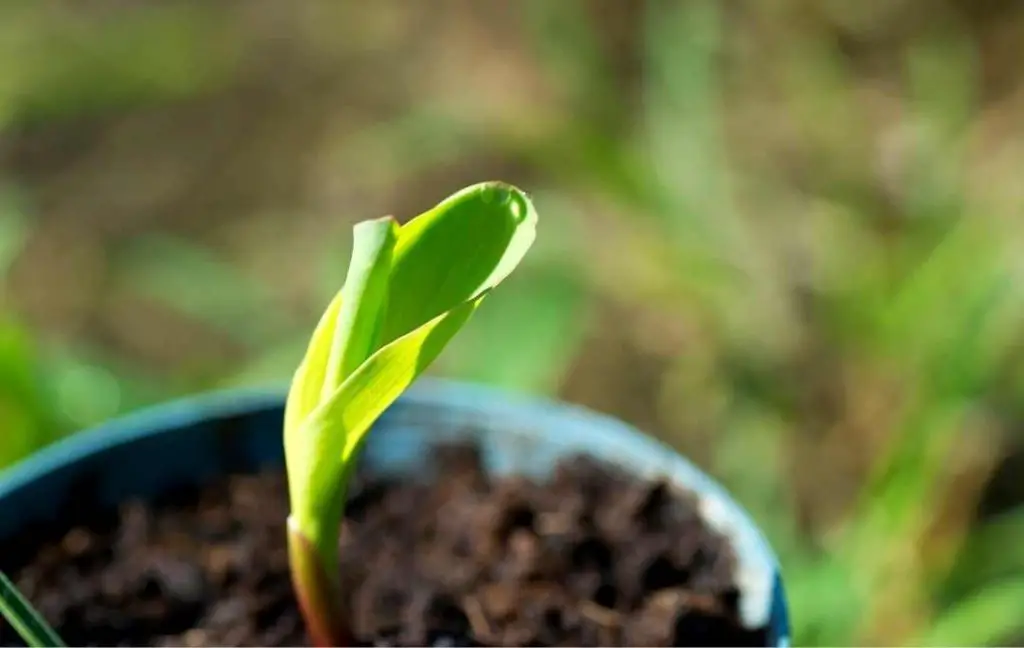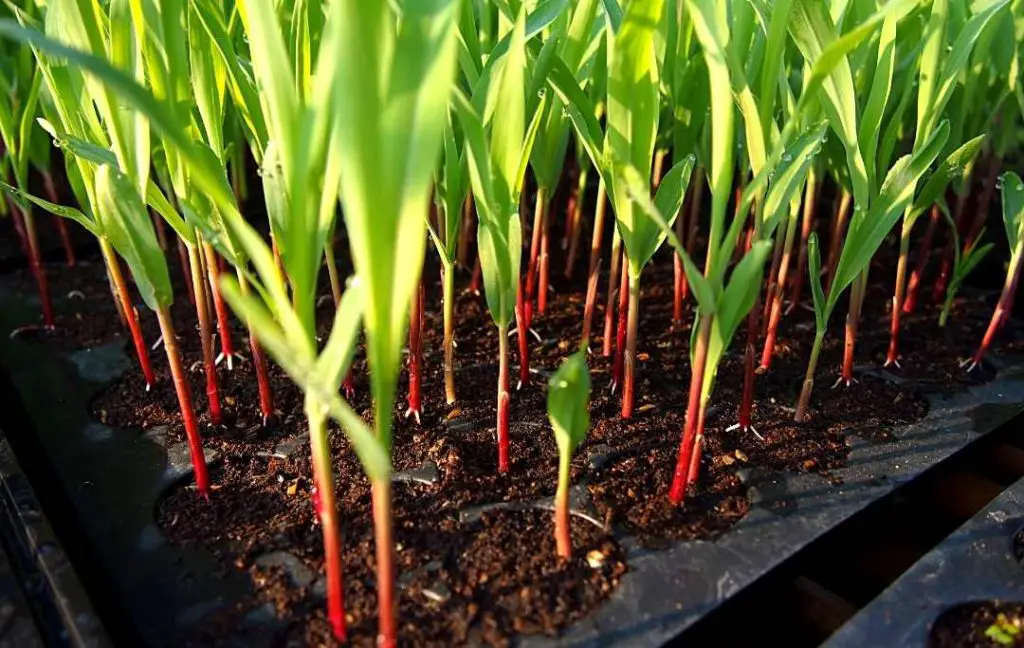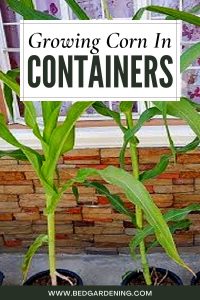Corn is a popular and versatile plant. When you think about corn then large fields of corn come to your mind. But it is not possible that everyone has large growing areas.
You can grow corn in containers if you are facing the problem of limited space. The right conditions and fulfilling all the requirements make it possible for you to grow corn in containers.

In this article, we are going to discuss with you how to grow corn in containers. But the yield you get from the container is less than the corn grown in the ground.
Best Time To Grow Corns
Corn likes to grow in the summer season so the best time to plant corn is in spring. You should plant corn early so your crop will get plenty of time for development.
After the last spring Frost, the temperature will reach 55 to 60 degrees Fahrenheit. This is a suitable time for planting but if you sow the seeds too early then it will cause the seeds to rot.
You can also ask any local nursery for the best time for planting. Your climate and location is very important in the growth of corn.
How Long Does Corn Take To Grow?
Your corn crop will be ready to harvest between 60 to 100 days after planting. The height of this plant can be reached 12 feet. That’s why this vegetable crop takes some time but the growth cycle of this corn is very fast.
Choose A Perfect And Large Container For Corn
The size of the container is very important as corn needs space to grow. It is a tall crop that’s why you should choose a large container. A 12 inches deep and wide container is perfect.
You should not worry about the material of the container, plastic or clay everything is fine. You can also recycle your useless things to make containers for growing corn.
If you have wooden crates, laundry baskets, or useless tires then you can use them for growing purposes. The only thing you have to keep in mind is the size of the container. It should be large enough so your corn plants will get ample space for their healthy growth.
The number of the plants depend upon the size of the container which you are using for growing cons If you are using a 12 inches deep container then you can grow 3 full-size corn plants easily in that container for growing more than three plants you need 20 inches deep container in a 20 inches deep container you can grow 6 corn plants.
Drainage is very important for growing healthier plants so you should take care of it. Make sure the container you are using has an appropriate number of drainage holes at the bottom.
Different Varieties Of Corns
There are different types of accounts available which you can grow in containers. You have to choose one and start planting. All the varieties are different from each other by height, texture, structure, and taste.
Here we are going to give you some options which are suitable for growing plants in containers.
1- SWEET CORN
Fresh corn is tender and juicy and perfect for your meal. Normally, sweet corns are found in yellow, but the other colors of this variety are brown and red.
2- POPCORN
This variety is perfect for making popcorn. Almost everyone likes to eat popcorn. The store-bought popcorn variety has a yellow-orange color but the variety which you’re growing at your home might even be blue.
3- FLINT CORN
This variety has a hard outer layer that has a glossy appearance. The texture of this variety is gummy. Like the popcorn variety, flint corn also pops when heated. Flint corn is used as hominy to make tortillas.
4- DENT CORN
The other name of dent corn is field corn. Farmers like to grow this variety because it can be used as animal feed. When dent corn dries up its center shrinks. Dent corn can be used for making cornmeal or hominy.
5- FLOUR CORN
Flour corn is soft and can be turned into cornmeal. The flavor of this variety is sweet.
Filling Of Container For Corns
Soil is an important factor for the growth of any plant. Your plants get all the major nutrients from the soil. Peat-based potting soil is the best option for growing corn plants.
You can also add compost, fish emulsion, chicken manure, and all-purpose fertilizer to make potting soil richer. This soil has all the basic nutrients which your corn plant needs at the start of the growth.
You should keep in mind that corn is a heavy feeder and it needs a lot of nutrients. For healthier development, moist soil is needed for the corn plant. But it doesn’t mean that you make the soil soggy or waterlogged.
Planting Seeds Of Corn

Starting your corn crop from seeds is a simple and easy way. Within a few months, you will see corn complete its growth cycle that’s why it is an annual crop.
For most of the plants, we prepare seedlings for transplantation but in the case of corn, we can so the seeds directly into the container.
After filling the pot with the best quality of the potting mix, you can sow the seeds 1.5 to 2 inches deep. You can grow 3 to 4 plants in a 12 inches deep container.
If you want to grow more plants then you should increase the size of the container. Now fill the holes with the soil and give water. The sunlight will do its work for you.
Within 10 to 14 days you will see the seeds will start germinating if the temperature is between 55 to 60 degrees Fahrenheit. If the temperature is 65 degrees Fahrenheit and above then the germination process will be very fast and you will see within 6 days the seeds will sprout.
When the seed sprouts you can thin the plants down. The roots of corn plants compete for nutrients that’s why the spacing is very important; the corn plants need sufficient room to breathe.
In a container, you have limited soil so it cannot support a ton of corn plants at a time. When you give space then it will make it possible for all the plants to get nutrients from the soil. When the seedlings reach a height of 4 inches then it is the best time to keep them strong and healthy.
Read More
Planting Seedlings Of Corn

You can buy seedlings from any gardening store or local nursery. This method will start your growing cycle early. Your crop will be ready soon because it saves time which is consumed for the germination process of seeds. This option is also best if you want a late start.
- First, dig the hole according to the size of the seedling in your desired container.
- Now remove the seedlings and transfer them to the hole.
- To provide support to your young seedlings, lightly pack some soil around the base.
- Spacing is very important during the transplantation; you should leave a gap of four to six inches. If you are using a circular container then you should plant the seedlings in a square. This will maximize the space.
- Make sure your corn plants get water regularly. An inch of water every week is enough for corn plants. If you maintain the frequency of the water then it will improve the texture and taste of the corn plants. If you choose the variety of sweet corn, then it needs moist soil for better flavor. Deep and slow water is recommended.
Find The Right Spot For Your Container
Location is very important for the development of your corn plants. As it is mentioned above corn is a warm-weather crop. So it means it needs an appropriate amount of sunlight. Each day your corn plants need 6 to 8 hours of sunlight.
The tall corn stalks can be used as a privacy wall. You are growing points in the container so you can place your containers at the place where you need a privacy wall. If you start planting in May, then the stalks will grow tall in the middle of the summer. The height of the container-grown corn can be 6 feet tall.
Common Pests
Pest and diseases can destroy your corn crop so it is better to know the common problems that your crop faces.
CORN LEAF APHIDS
Invasion of aphids can deform corn tassels. You should keep an eye on your plant. Take action at the right time and save your plants from these tiny monsters.
CORN FLEA BEETLES
Flea beetles affect the young corn seedlings in the spring. If you see small circular holes on your corn plant leaves, it means your plant has become the victim of a flea beetle.
CUTWORMS
Cutworms move from plant to plant and affect almost all plants in your garden. Cutworms like to eat the top part of the plant.
SOUTHERN CORN ROOTWORM
This insect not only likes to eat the roots of the corn but also affects the heart or bud of the plant. You should keep an eye on the leaves of the corn plants because the rootworms are small. That’s why it is difficult to point out at times.
SEEDCORN MAGGOTS
Maggots affect the corn crop in the spring season. When the seeds of the corn are in the germination process there is a need to pay attention to seed corn maggots.

Harvesting
When you grow corn in the container then the harvesting is the same as in the garden. The maturity time of corn is about 60 to 100 days but it depends on the variety which you are growing. Weather conditions matter a lot during the growing period.
- As you are growing corn in the pots so it is not possible to get a high yield. You can increase production by choosing the container-friendly variety of corn. Your attention is also essential during the growing process.
- If you want the best pollination then you should plant the stalks close in the container. You can grow at least four stocks in each container.
- You should harvest corn in the early morning. This is the best time because the sweetness level is the highest.
- For harvesting the corn, you should grasp the ear firmly and pull it downward. After that twist the ear and pull. This is an easy way to pick the stock quickly.
- Harvest the corn according to your need. You should eat the corn within a few days.
